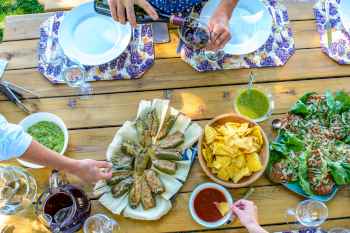You’ll Know if You’ve Seen a Wood Duck!
These are distinct, stunning ducks! The male is a patchwork quilt made up of an iridescent green and chestnut-brown head with a red eye, bright red and yellow on the beak, white-spotted brown chest, delicately patterned buffy belly, blue accents on the wings and bold white markings delineating each area. The female has lovely blue feathers accenting her wings – a “speculum” patch – providing contrast to her primary grey/brown colour, and a lovely white teardrop around the eye complemented by a striking yellow eye-ring.
Environment for the America’s has selected an absolutely gorgeous duck to be one of the ambassadors for The Birds of World Migratory Bird Day 2024!
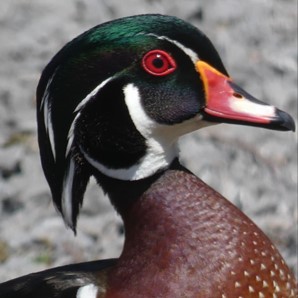 |
 |
|---|
Left: Close-up of a male Wood Duck’s head with its striking red eye.
Right: Close-up of a female Wood Duck with her bright yellow eye ring.
Photos by Janette Niwa
Why are they named Wood Ducks, you ask? Because they nest in tree cavities (or nesting boxes) and can be seen flying gracefully through forests, surprising many a human! They are one of few duck species who have claws on their feet which allow them to grip and perch on trees.1
Where can you see these beauties?
Wood Ducks breed across much of the US and southern Canada, but they aren’t year-round residents where it gets cold. Instead, many migrate south to spend the winter in warmer regions like Mexico and Cuba.2 You can also see a photo of one right here:

Wood Ducks (foreground) are considerably smaller than Mallards (background).
Most Wood Ducks avoid the snow by flying south in winter.
Photo by Nui Soonthornhut Esser
As you can see, Wood Ducks are much smaller than Mallards. Where Mallards are 50 to 65 cm in length and weigh 1 to 1.3 kg3, Wood Ducks range from about 47 to 54 cm and are only 454 to 862 grams4. Look for these medium-sized ducks in trees or water in wetland areas like swamps, freshwater marshes, and beaver ponds. You’ll also find them at rivers and streams where there’s vegetative cover like plants and downed trees where they can forage and hide.
Comparing Ducks: Dabbling vs. Diving vs. Perching
Some ducks dive underwater to get food from the depths of the bottom, reappearing after a while further away. Others dabble with their butt up and head down, reaching underwater to pull food from the surface and shallow depths. While Wood Ducks eat by dabbling, just like Mallards, they have a more defining characteristic. Unlike most ducks in Canada, they perch on trees, thanks to the claws on their feet! Previously categorized as dabbling, this has changed, and they are now generally categorized as perching ducks.5
Primarily an herbivore, Wood Ducks eat plants such as duckweeds, grasses, sedges, waterlily, and pondweed, as well as seeds and acorns. They also rely heavily on protein-rich bugs including dragonflies, beetles, caterpillars, and spiders.6 Living in marshes and swamplands, a healthy habitat for bugs makes foraging for snack food much easier! As with the other bird ambassadors for Nature Canada’s World Migratory Bird Day, Wood Ducks are relying on us to keep this habitat healthy, pesticide-free, and supportive of native species.
Are Wood Duck ducklings as Beautiful as the Adults?
Let’s be honest – ALL ducklings are adorable with soft, fluffy feathers, cute little “cheeps”, their innate ability to dive underwater for safety, and their delightful cuddle-puddles! While they look similar, Wood Duck ducklings can be differentiated from Mallards by their colour. Instead of looking yellowish like Mallards, Wood Duck ducklings generally have white bellies and brown backs with longer tails. But perhaps the biggest difference, besides size, is the “eye line”. In Mallards the black line goes from the beak to the eye and then continues from the eye back, while for Wood Duck ducklings the eye line only starts at the eye.
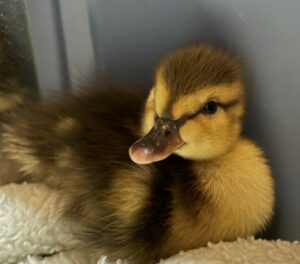 |
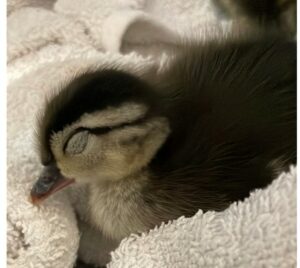 |
|---|
Can you identify the duckling species?
On the left is a Mallard and on the right is a sleeping Wood Duck – notice the different eye line.
Photos by Christina Huppé
Female Wood Ducks do all the work to take care of eggs and ducklings, and they are busy ladies, generally having 1 to 2 broods per season and 6 to 16 eggs in each clutch. They nest in pre-made tree cavities anywhere from 1 to 18 meters high – and higher is generally better. The females commonly practice “intraspecific brood parasitism”, laying eggs in the nests of other Wood Ducks.7 After about one month of incubation, the young hatch alert and use the claws on their feet to crawl out of the cavity interior and jump out to the ground one day after hatching. Light and fluffy, they generally bounce on the leaf litter on the forest floor. It takes 7 to 10 weeks for the fluffy ducklings to grow into full adult Wood Ducks, ready to fly south for their first winter.
While most Wood Duck mums choose a tree close to the water, not all do. Some nest almost as far as 2 km away from water, which is why sometimes you see a brood of ducklings in awkward, unsafe places. Wood Duck ducklings may have to navigate a complex maze of streets, fences, pets, and predators to reach water – but you can help!
Duckling Rescue
Bird rescue organizations and rehabbers receive a lot of calls in the summer about orphaned or injured ducklings. In Canada’s capital, Safe Wings Ottawa has taken on the rescue and fostering of ducklings for the past two years due to the challenges avian influenza and quarantine requirements present. Safe Wings has mainly received Mallard and Wood Duck ducklings, with a few Common Mergansers as well. Wood Duck ducklings are quite “delicate” compared to the more robust Mallards.
Wood Duck ducklings are notoriously hard to rehabilitate. Unlike the more laid-back Mallards, they are very high-stress and require specialized care. This includes tube feeding every 3 to 4 hours from dawn to dusk until they start to self-feed, sauna time twice a day, and putting them in “time-outs” if they become too anxious or stressed during the day. Additionally, they require a location where they can burrow and stay warm and an enclosure that is high enough to prevent them from jumping out.
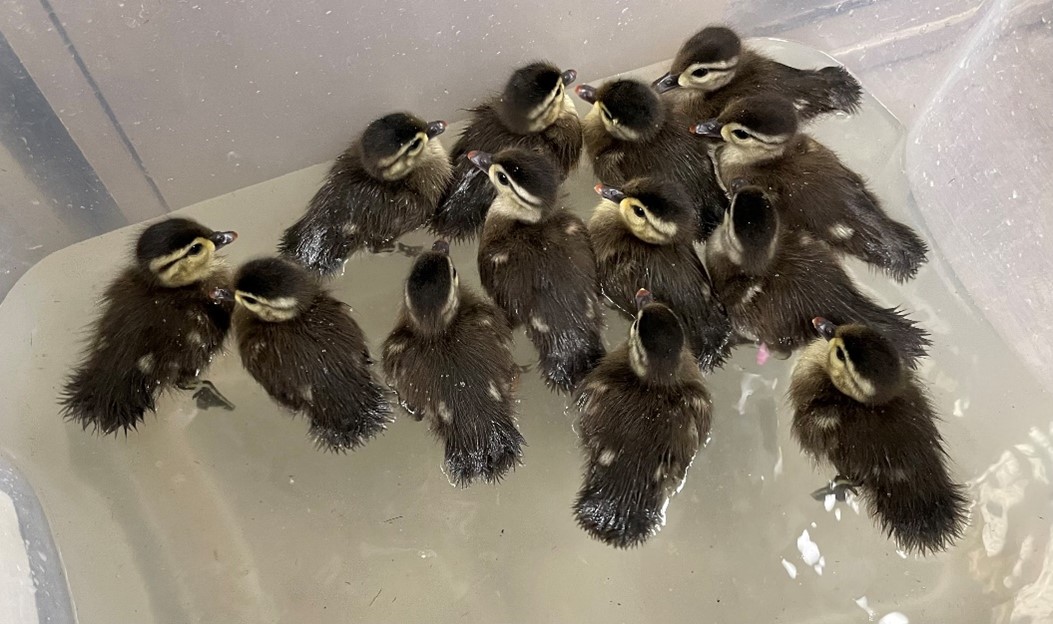
Wood Duck duckling in care with Safe Wings
Photo by Christina Huppé
Given how challenging it is to raise Wood Ducks, this task is best done by their mothers. Here’s how you can help keep Wood Duck ducklings in the wild.
Ducklings are swimming in my pool or in my yard – what do I do?
If you find a brood of ducklings in your backyard, pool, in courtyard, trying to cross a street, or anywhere that seems hazardous, you can help get them safely on their way by giving them space and keeping them away from dangers like pets and cars. You can call a wildlife rescuer or rehabber for guidance, or the local police non-emergency line for help with traffic (never put yourself in danger). No matter what, it’s best to act quickly.
Pools present a surprising danger to ducklings, as they can jump in but often can’t get out and may tire and drown. Whether for ducks or frogs, squirrels, chipmunks, or your pets, it is ideal to leave a plank with non-slip “grippy” material at the edge of the pool so that animals can safely escape. Placing the edge parallel with the side of the pool is best because any animal trying to get out will circle the edge and find the ramp. Alternatively, you can purchase pre-made products like the Frog Log or similar items.
Window wells are another hazard for ducklings. Birds, frogs, and other small animals fall into the well and cannot get out. Checking regularly can save a life and another non-slip ramp provides a safe way out.
Check out these tips from the Humane Society. If you do get ducklings stuck in your pool or window well, put in a ramp or floating material, and give a local bird rescue a call right away!
Enjoy the Beauty of Wood Ducks
Whether you’re enjoying a flock of ducks on land, a raft of them paddling in the water, or a skein of ducks flying overhead7, be sure to look for the beautiful Wood Duck. You can show your appreciation by helping to protect Canada’s wetlands, with its richness of vegetative food and insects, and by keeping an eye out for ducklings in need of a helping hand. Cheers to one of the wonderful ambassadors of World Migratory Bird Day 2024!

